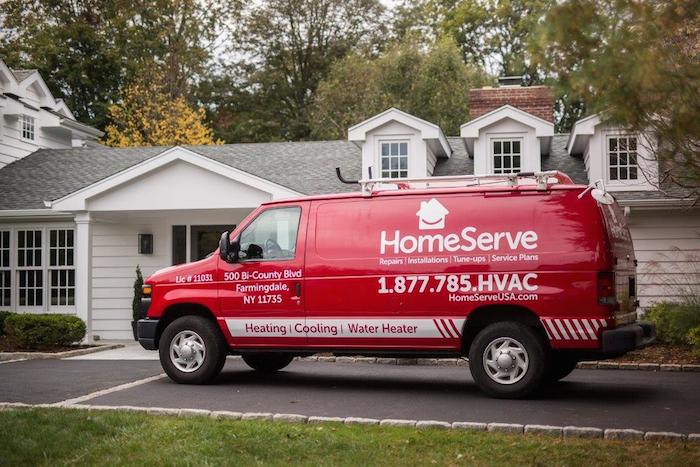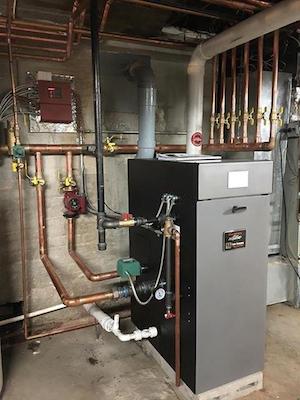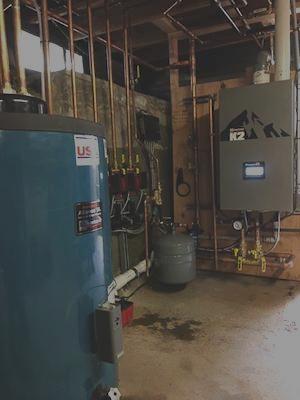It was 1995 when Richard Kopec came to the United States. He was 18 years old and he started working immediately after arriving on U.S. soil. He walked onto a jobsite in New York City and did his best to communicate to the foreman that he wanted work. He started a career right then and Read more
U.S. Boiler

It was 1995 when Richard Kopec came to the United States. He was 18 years old and he started working immediately after arriving on U.S. soil. He walked onto a jobsite in New York City and did his best to communicate to the foreman that he wanted work. He started a career right then and there.

HomeServe’s Farmingdale location, in Nassau County, NY, has 43 service technicians,10 install technicians, and 20 seasonal apprentices.
Years passed while he lived in Queens and practiced plumbing and commercial hydronic work. Kopec got married and co-founded his own plumbing company. That went well until his partner died in a boating accident. He spent a few years working for another Manhattan firm before he and his wife decided to move to quieter surroundings on Long Island to raise a family.
“For awhile, I commuted to the city from Long Island, but traffic on the Expressway is horrible. I spent half my day driving, it seemed,” said Kopec. “Eventually I got a local job, and in 2007, I got my Master Plumbing License.”
By the time Kopec completed his license, he was working for Keyspan (HomeServe), out of the Farmingdale, N.Y. branch. He was part of the service crew and developed a real knack for high efficiency boilers, even though he wasn’t working on them every day. He started doing most of the company’s condensing product service work, and today, he’s the service manager for Nassau County since 2014.
Stiff competition
Kopec lives and breathes residential boiler swap-outs. New construction is rare, and so is condensing equipment in his area.

HomeServe installed a U.S. Boiler Alpine 210 to serve a 4,000 square-foot home with hot water coils.
“We remove a lot of sectional boilers and replace them with new cast iron models,” said Kopec. “More often than not, we’re installing the U.S. Boiler Series 2 or Series X-2. It’s a really tough market here, and we’re competing against a lot of cheap alternatives, whether that be product or workmanship.”
HomeServe’s Farmingdale location has 43 service technicians,10 install technicians, and 20 seasonal apprentices. More often than not, the company’s boiler crews can pull and replace a boiler in less than a day, but on occasion, a job comes along that bucks the norm.
Last fall, the HomeServe team got that opportunity. Serving over 55,000 customers on Long Island, one of them called for service, but their existing boiler was no longer up to the task . The customer wanted a high-efficiency alternative anyway.
The house was about 4,000 square feet, zoned with six hydrocoils in the ductwork and a 119-gallon indirect storage tank.
After a load calculation, the system was designed around a U.S. Boiler Alpine mod-con. Most homes on Long Island call for a 105 or 150 MBH unit, but this home was bigger. They needed a 399 MBH unit. The largest Alpine they’d ever installed up to that point was 210 MBH.

The new Alpine boiler now provides heat for six zones and a large sidearm tank.
“We use U.S. Boiler products—whether cast iron or condensing—for a number of reasons,” said Kopec. “The support we get from Venco Sales is great. More importantly, the efficiency provided by the Alpine is pretty amazing considering the simplicity of the unit. In my little experience with the K2, this holds true across the U.S. Boiler condensing line. And then there are things you find on the Alpine and K2 that aren’t common among other condensing boiler brands. For example, the control board is above the wet components. You’d think that would be common sense.”
On day one of the project, the two-man boiler crew tore out the old system. A subcontractor was hired to line the chimney with flexible polypropylene vent. Combustion air was delivered through the basement wall.
Day two came and it was time to set the boiler. To speed things up, HomeServe generally installs premanufactured primary/secondary piping. Kopec says this easily knocks two hours off a job. But the 399 MBH unit required two-inch near-boiler piping, which isn’t a stock item. So they made their own out of copper onsite.
“When we install boilers, we keep ease of service in mind,” said Kopec. “We put Webstone isolation valves on all our systems for that reason. The service guys love us for it.”
The boiler was fired halfway through day three.
No news is good news
“Despite the bitter winter, we haven’t heard a peep from the homeowner, and that’s always a good sign,” said Kopec. “The most important thing when swapping out a cast iron boiler for a condensing boiler on a hydronic coil systems is making sure that the boiler is condensing without sacrificing system responsiveness. The Alpine is 95 percent efficient, and we want to capitalize on that.”
Based on the size of the coils in the ductwork, Kopec was able to maintain a 20°F Delta-T. His outdoor design temperature is 25°F, and supply water temperature fluctuates between 130 and 180°F, per the outdoor reset control. Of course, the indirect tank has priority.
“The Sage 2 controls on these boilers is very user friendly, and especially helpful during start-up and combustion testing,” said Kopec. “I can see exactly which limits are open, etc. The best boiler in the world won’t perform as intended if it’s not set up properly.”
The diligence and attention to detail HomeServe takes to each and every job is apparent. They deliver on their motto; “Say hello to peace of mind.”

Skimming a steam boiler is the process of removing any oil from the water volume. If not completed properly, the presence of oil can cause the boiler to surge, as the water’s ability to flash to steam is affected. While US Boiler doesn’t use oil in the production of sections, oil can come from the Read more
Skimming a steam boiler is the process of removing any oil from the water volume. If not completed properly, the presence of oil can cause the boiler to surge, as the water’s ability to flash to steam is affected.
While US Boiler doesn’t use oil in the production of sections, oil can come from the inside of black pipe and also from the threading process.
In my past life, we installed many steam boilers, following the installation instructions to a “T.” When we started doing it by the book, it was a tough transition from our old ways to re-educate ourselves. For years, we never did proper near boiler piping, even though we thought we were. We just did it our way because that’s the way the company had always done it.
Our way worked OK and was easier. Usually after a few trips to the surging steam boiler and re-piping, adding chemicals, trying check valves or just skimming, we were able to resolved most of the problems.
Of course, all these additional trips were not included in the installation price, so it became a financial loss for us. I realized most surging problems can be resolved just by skimming properly.
I finally looked into the skimming procedures. After asking a lot of old-timers, I found that there were many ways to skim a steam boiler. Some seemed to work better than others.
As we gathered the information, there were many similarities between the techniques that the older techs were using. And of course there some differences. We decided to combine all the similar steps and added a few others we had heard.
With some trial and error we found that on most jobs we only had to skim one time and usually only for about an hour or so. We also realized we didn’t need to use chemical additives. Prior to this we always used chemicals after skimming.
If you don’t do much steam work you may ask what surging is? This is when the water level in the gage glass is bouncing excessively. The bounce should not be more than about 1/2″- 1″ When surging, the water bounce will normally be most of the sight glass and the water can even completely disappear. The water may just keep dropping and disappear without much bounce. Remember this, the action inside the boiler is worse than what you are seeing in the gage glass.
Here’s the proper skimming procedure we used:
- Turn the boiler on and run it until it gets hot starts making steam.
- Turn the boiler off. DO NOT TURN THE BOILER BACK ON DURING SKIMMING PROCESS. This is important. If you fire the boiler again, it’ll cause turbulence within the water volume, drawing oiler away from the surface.
- Only after lifting the relief valve to verify there is no steam pressure in the boiler, find the skim tapping or a plug you can safely remove above the water level. If the relief valve is on the side of the boiler you could even use that taping. Not taping can be used on top of the boiler, only on the sides. The tapping must be at least 3/4″.
- Install a nipple with a valve into the boiler taping. The valve is a “just-in-case” valve. You won’t close this after the skimming process starts. This pipe nipple must be horizontal, and must come straight out. It cannot elbow up. We are trying to skim the water surface, so the water must come out of a horizontal pipe. There shouldn’t be water at this level yet.
- Open the valve you installed and hang a bucket on the pipe.
- Find the manual fill valve. If there is no manual valve you can add the water into the boiler from a low drain valve.
- Open the manual fill valve until the water starts to flow out of the pipe nipple and valve you just installed. When water starts to flow out the pipe nipple, close the fill valve and wait until the flow stops.
- Reopen the manual fill valve slightly so the stream of water coming from the pipe nipple is no larger than a wooden pencil. A little faster for commercial boilers. The slower the better.
- Continue to skim until the bucket is almost full and remove the full bucket and use the second bucket while you dump the first bucket. Do not shut off the valve while doing this. You cannot not stop the water flow once started. Remember – Do not re-fire the boiler.
- Keep skimming until the water temp falls low enough that you can comfortably keep your hand under the skimmed water flow. I know jobs that were skimmed 2 – 3 hours depending on boiler water volume. Many times this is about an hour on residential boilers.
- When done, close manual water feed, remove pipe nipple and valve, reinstall plug or relief valve, drain water to proper fill level.
- Turn the boiler switch on. Let the boiler create steam. Did the surging stop or at least improve? Duplicate if needed but normally once is enough. If after two tries there’s no improvement, the problem is not oil. Check near boiler piping, flame impingement, and water pH. Water pH issues can be caused by chemicals added to the boiler.
 Ron Beck is the outside Technical Advisor and manager of Training for U.S. Boiler Company, where he’s been since 1998. Ron’s 38 years of experience in the heating industry include climbing the ranks of a HVAC company, from apprentice to service manager. “Ron offers technical tips every month in the US Boiler Report, ” which can be found here.
Ron Beck is the outside Technical Advisor and manager of Training for U.S. Boiler Company, where he’s been since 1998. Ron’s 38 years of experience in the heating industry include climbing the ranks of a HVAC company, from apprentice to service manager. “Ron offers technical tips every month in the US Boiler Report, ” which can be found here.
